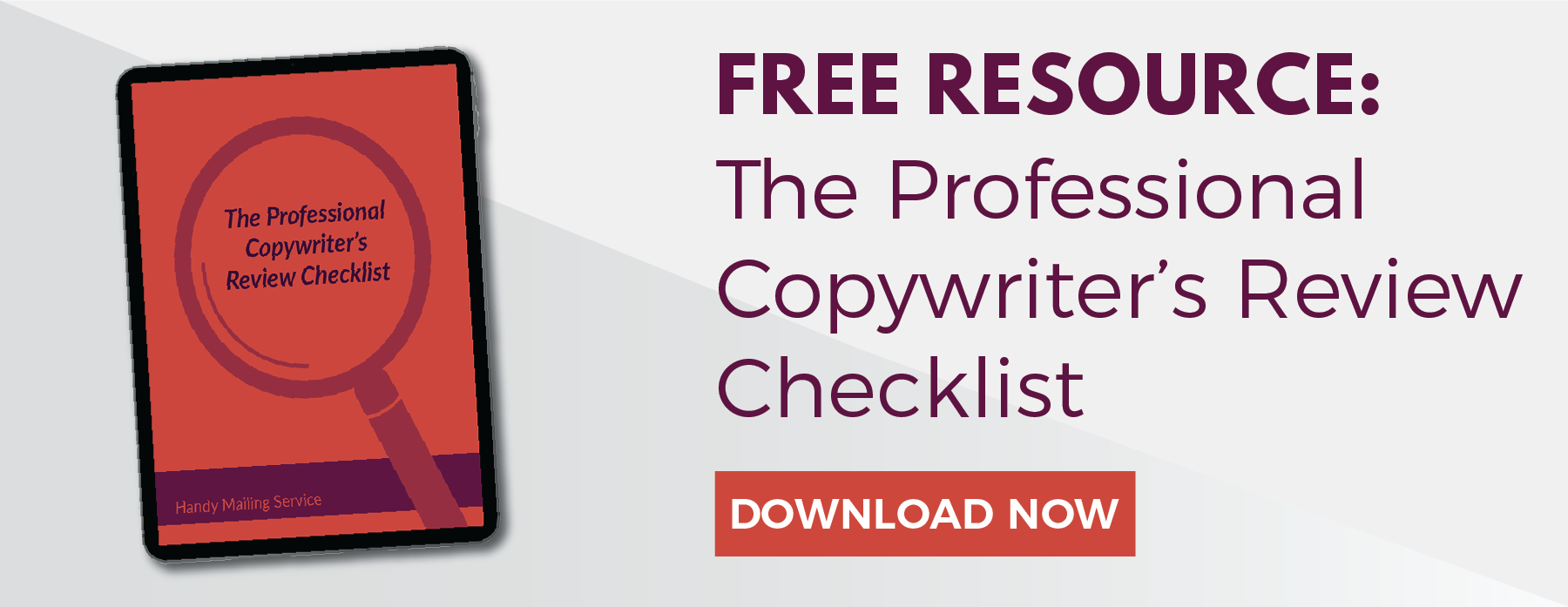A sales letter is a piece of direct mail designed to persuade the reader to purchase a particular product or service in the absence of a salesman. It has been defined as "A form of direct mail in which an advertiser sends a letter to a potential customer. This definition from Wikipedia really hits the nail on the head.
For you, a sales letter could be many things. Maybe it’s your bread and butter marketing piece, or your “ace in the hole.” Maybe it’s what puts food on the table week in and week out. Regardless your situation, there’s no denying the power and effect that a sales letter has for any business, organization, or person. It’s the most foundational pillar of direct mail. But, as the years go on, there’s a good chance that your sales letter has become less effective than it was in its heyday. Times have changed and so have the ways customers perceive sales letters.
Download the professional copywriter's review checklist!

It’s time to give your sales letter a boost with these three quick tips.
- Headings and Subheads
- Use of Copy Doodles and Graphics
- Testing Different Materials
Headings and Subheads
Did you know they say the average human attention span is down to around eight seconds now? In fact, some studies even suggest that goldfish may have longer attention span than humans. But wait a minute, you’re expecting a prospect to read your sales letter that can be anywhere from a couples pages to even 20? Let’s be real about this. It’s hard to sit down and read something uninterrupted and undistracted in today’s world. So put yourself in the shoes of your prospects. Are they going to be able to make it to the end of your letter?
A big way to keep them on track is headings and subheads. These are the sentences or phrases that stand out in your letter with a bigger font size, different style, or different color. These guide the reader along and helps them stay on the path to the end. If your letter is longer than a page or two, you need to be utilizing these. Without guideline markers, there’s a good chance your reader could get lost or distracted. Use these headings to continue moving them through. Use them to highlight important problems, thoughts, solutions, or benefits. This will keep them enthralled and helps break up the paragraphs into easier reading sections. Depending on the type, style, or length of your letter, a good rule of thumb is a headline every 3-4 paragraphs. This can vary with what type of sales letter you’re writing. Usually though, it’s best to insert them when you’re transitioning from one idea to the next.
Use of Copy Doodles and Graphics
A lot of text on a page can get pretty boring to about 99% of the human population. (if you’re in that 1%, I’m sorry) So find ways to spice it up and point your reader to the things that are most important. These are the ideas and points that you absolutely don’t want them to miss. One great way to do this is use of Copy Doodles. These are hand drawn doodles, graphics, symbols, and fonts that you can insert into your sales letter. They help draw attention to what matters most in your letter.
CopyDoodles are used by some of the most successful direct mail experts out there including Dan Kennedy himself. It grabs the reader’s eyes and directs them to an important idea. Sometimes we’ve seen them used at the bottom of the page and say “Turn Over” or “Flip Page.”
Or you can insert them as arrows pointing to an offer you have at the bottom of the page.
Don’t feel like you're limited to using just CopyDoodles. You can incorporate your own handwriting, scribbles, or arrows. It’s easier than you think. All you have to do is print out your sales letter, make the marks you want, then scan it back onto your computer. Now you have your sales letter with your actual handwriting to add to the authenticity of your letter.
Here’s a letter we sent out where we used some stars and circles to highlight something important. We wanted to make sure the reader didn’t miss the opportunity of a great offer.
Material Variations
The third aspect I want to talk about is material variations. The most common form of sales letter we typically see is an 8.5x11 letter on standard 60# text in black and white. You know you don't have to do that, right? Test out different ideas like making your sales letter into a 11x17 newsletter half folded to 8.5x11. Or cut it down to 7.5x11 so something is different about it.
Another big variable you can change is the paper type. If you’re going for a more professional look, print it on a nice linen paper or even off-white linen. Looking for something more personal? Print it on lined yellow paper or the super thin newspaper. You may be missing out on a major improvement if you aren’t trying different types of paper. Make minor adjustments with each letter you send out to find out what works best. Once you have the secret formula nailed down, ride that puppy until you need to make more adjustments.
So which of these tips have worked best for your sales letter? We would love to hear about the successes you have had with these improvements.


